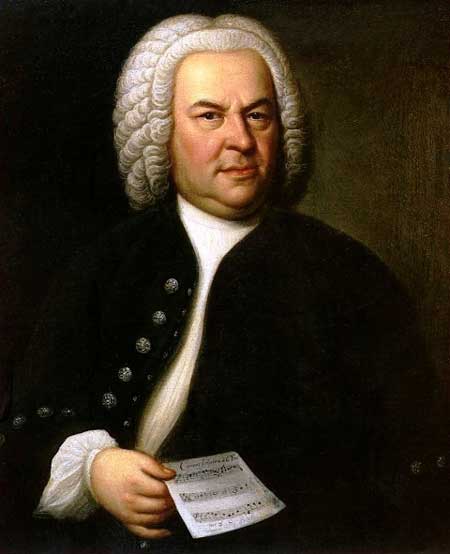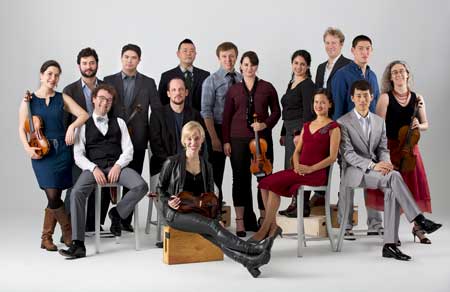Concert
The Goldberg Variations
Arranged by Sarah Darling, Alex Fortes, Simone Dinnerstein, and A Far Cry
A Far Cry
Simone Dinnerstein, piano
Jordan Hall
Symphony Hall area, Boston
February 8, 2019, 8:00pm
Violin: Annie Rabbat, Emilie-Anne Gendron, Jae Cosmos Lee, Jesse Irons, Liesl Doty, Megumi Lewis, Omar Cheri Guey
Viola: Ayane Kazasa, Jason Fisher, Molly Carry, Sarah Darling
Cello: Hanna Collins, Michael Unterman, Rafael Poper-Keizer
Bass: Karl Doty, Kris Saebo

A Far Cry is a terrific Boston-based string chamber ensemble that has begun to make real waves all over the place. They are currently up for a couple of Grammy Awards (for Best Small Ensemble Recording and Best Engineered Recording), and they certainly deserve the recognition.
They are nervy, though not crazy, and have applied an interesting touch to the great piano work that Glenn Gould brought to prominence in the mid-1950s.
As A Far Cry violist and one of the arrangers of The Goldberg Variations, Sarah Darling asked in her wonderful introduction to the evening, why try to modify a piece that is already perfect? There is already so much wonder and intricate internal relationship present in Bach’s work, why mess with it? In response to her own question Darling offered the thought that The Goldberg Variations, like any great work, is suggestive as well as, in some sense, complete in itself. So, what calls out as presenting a path into a trio sonata, or other forms, inspired the group to take wings and explore some of these possibilities.
The results are wonderful. With brilliant pianist Simone Dinnerstein playing the core of the piece, surrounded by the fifteen wonderfully adept and eloquent string players, the landscape of The Goldberg Variations takes on yet new shapes and forms.
The aria and thirty variations were played without an intermission, though the group did break halfway to tune.
Percussive surprises of various sorts were in evidence throughout, with jazzy bass plucking, insistently manic viola plucking, and even, near the end, hilariously, piano plucking.
As Darling noted, the group is intentionally democratic, and that vibe makes itself eminently clear. All of these musicians shine, and each is a star in their own way. Remarkably, they have different auras, different strengths, different qualities of interpretation, but the sense of mutual generosity is eminently evident and it renders a generous sense to their playing.
Notes on the performance
Sarah Darling’s intro (in the first person, though not verbatim)
Why arrange a perfect piece of music? It’s a piece that begins and ends in the same place but the end is so different because of the path traversed. Along the way there is tragedy, fun, peace. What we hope to do is bow down in reverence before it.
Each part suggests a lot more – a trio sonata, a French opera. What would it be like to explore some of these? We didn’t want to just write an “adaptation” for string orchestra. We decided to embark on it as an exploratory venture.
So, how do did we do it? Each one of us listened and began to interpret it, and we put our ideas together on a spreadsheet. In tune with our democratic approach, we wrestled, wrangled, came up with something, and brought it to Simone Dinnerstein, and there was yet more process, which we fondly dubbed The Goldberg Process. it’s always such a great pleasure to work with A Far Cry because of its democratic process and the great sense of awareness of each member which results from that, and which leads to such a “cornucopia” of states of being.

The Goldberg Variations
Aria
The piano begins, as ever, with with such delicacy and grace. Dinnerstein gives such wonderful modulation to the elements of the introductory phrase. Then, it repeats, this time with the cellos offering long bow support beneath. Now, all of a sudden, the piece takes on the flavor of a trio sonata. The piano returns – and then the violas enter with little trills, embellishing the simple theme with a few ruffles. And the violins enter as well, simply and elegantly. The additional voices now enter together, painting a landscape. The plaintive solo piano is now in modified concerto territory.
Variatio 1
As this first variation begins this indeed concerto territory, but concerto grosso territory. After the violins have their elegant say, the piano responds, sometime as accompanist – how strange and interesting!
Variatio 2
A plucked bass enters here – are we at The Village Vanguard? Terrific! But there’s the piano reminding us we’re on Bach Planet Earth. The violins come in to speak their piece and now make this a delicate dance of multiple voices. How the piano rises up with its clarion call, now a voice not just alone, but of the people.
Variatio 3
The lovely Arioso – delicate, plaintive – with harmonizing violas making their ways through the underbrush. Then a solo cello butts in – a little more pronounced, a bit more majestically, counterpointed against the piano so adeptly, now in quiet conversation with it. Dual violas come back again, their duality pronounced, as though asserting debate.
Variatio 4
A clear declaration from the orchestra sets off this brisk walk in the breeze with swinging arms. The orchestra has it all now – no piano to be found.
Variatio 5
Ah, but there it is now, with flying fingers, like a hummingbird darting around the walkers. Boy, can it, can she, move! Now they’re all dancing together – walkers and hummingbird.
Variatio 6
Now a sashay, a bow, a slowed pace. The violas hold sway, then a beautifully plucked bass pushes them along. The piano unfolds like a pastel painting.
Variatio 7
A little sweet jig passed between piano, viola and cello. This is such a lovely, democratic group – no leaders, no hierarchy – it’s a great town meeting of individual speakers, each with its own vision. And there’s the piano, not as leader, but as the gently prodding coach.
Variatio 8
Now the piano has its say – in a mouthful of paragraphs, and the orchestra responds in careful unison. It’s a big statement. Now that piano voices races like a demon, but it’s never very far from its responding community. How gracefully it ends!
Variatio 9
A stately strut – is this a cloister? The pace is gentle, the thought is gentle, the give and take modulated. This is quiet conversation between friends in which words suggest, respond, turn, shape, almost without effort.
Variatio 10
The basses begin, almost like an elephant dance, then all the other creatures enter, finally followed by the singular piano, its voice clear.
Variatio 11
The the piano picks up its tempo, getting more complex as it gets answers by string pairs. A long of network of interlaced conversations ensues.
Variatio 12
A gently stepping pace thrust forward by the bass. Then everyone joins in. We’re now in the heartland – unwinding a sense of the countryside as expanse. We pace through it and gaze, as we do, into the remote distances. The piano re-enters and reasserts itself as though to encourage more conversation, which follows.
Variatio 13
A lovely little pianistic aria, like swimming alone in a river pool. And I walk along the rocks, balancing, barely. But then I find my feet. The piano repeats its theme, then is joined by a viola in lovely, delicate dialogue. Two swimmers gently erupting the surface of the pool, graduating adapting to one another. And, as they swim, they begin to entangle. Things heat up – the piano accelerates but the viola says Hold on, take it slow! and they do, with a bit of building subliminal energy. The piano has a reverie by itself – how wonderful to lie on the rocks in the sun beside the water, to let the world unravel!
Variatio 14
A ferocious pianistic opening, now reasserting itself. We must get back to work – enough of this lounging! And she leads the minions to dance wither her back to the maelstrom of life, which they do, energetically.
Variatio 15
Marche funebre. Don’t overdo it, or this is where you’ll wind up! But, cautiously aware, we must all realize this gravity, this soft underbelly, is there in all we do. The piano enters dolorously, but not without wisdom. Remember, in the midst of your frenzies, the prevailing poignancy. It ends with a piano prayer and a confirmation by the crowd – yes, we know – you are right! We subside a bit from our prideful reveries to regroup and reflect. tonal reaching by piano, cello and violin, son gently understated!

Variatio 16
A grand entrance, worthy of a queen. So dignified and full of pomp. Let’s do it again. This is a parade of dignitaries. Now they kick off their shoes and dance, throw off their frocks, pick up their feet and let it all hang out.
Variatio 17
The piano is of course the wildest dancer of all and running with ferocity as a lone violist tries to keep up, plucking. Woe is he! He does pretty well, as it turns out – maybe she’ll give him the time of day after all.
Variatio 18
Now this is a nice string trio, followed by a very measured piano, stating the obvious with clarity and grace.
Variatio 19
The piano does a soft shoe. Two set of violas join in – sweet and easy, Gene Kelly type dancing, nothing too crazy. Interestingly, one of the violinists moves over to the other side.
Variatio 20
Oh, now I see. The two violins and the cello go crazy and then they induce the crazy pianist to join in. It’s a tarantella – they’re all over the place – how they all jig wildly. Yes, we can do this without drugs! Watch me fly, jump across mountain streams and gullies.
Variatio 21
Quiet, with cello, around a campfire. The cello and piano nestle the fire, toast coffee, sit under the moon. Now the violas, and the evening clouds, set in. A high cello, like a sad coyote, calls out, and its mountain cry, through violins, responds. The clouds grow, night envelops. The piano, like embers of fire, glows in the crevices, held open by the cello and the searching night.
Variatio 22
The piano aria re-enters as lilac dawn, a quiet prayer. How lovely she plays this. Now they’re singing! Oh my God, how great, how weirdly wonderful, how unsculpted. Yes, they are musicians! What can be better than this?
Variatio 23
Now the piano runs down the mountain, a charging stream making its way over the rocks. Now all those fiddlers are running after it, even the plucking viola guy. But she’s fast, the olde piano sprite! It’s a race down the mountain.
Variatio 24
A break for a snack, though still panting. As any good hiker knows, the rests are crucial. But is a gently yogic rest, full of inner sway and its own subtle resolve. These are the eddies of the outward endeavor, the inner ripples.
Variatio 25
A declaration of grief, but not without irony. I will search for significance but humble before the majestic inconsistencies. And won’t those ultimately give me the courage to find those odd unsought for miraculous notes which give life its meaning? The violin restates the plea, now in the vernacular, more sweetly comprehensible and oddly becoming incorporated into the canon of repetition. Plaintive, wonderful, this is now articulate prayer. Gradually, the gang joins in, sweetly, devotedly. And the piano, finally, subtly, articulately, with unique recognition and a continuing existential pain. How articulate and wonderful it is, at the depth of its sorrowful, sweetest, self.
Variatio 26
Now they’re on the run again. The strings don’t even try to keep up with the crazed piano, juggler of nine balls. They sit by and smile while she makes the balls dance before their eyes.
Variatio 27
Fancy little snatches of bow – now we’re into modern art. But they finally engage in civil dialogue – we know how to be adults! A violin and cello have a devilishly complex exchange.
Variatio 28
Now the pianist is plucking!!! Can this get any better? And the rest of them are plucking, except for the tight little mini-trillers. This is just too good! Can I go to bed to this delicate plucking lullaby? The plucked piano is too surreal! Love it. This is interstellar Bach – can I have my spacesuit please?
Variatio 29
The crazy piano reasserts itself – this is mambo-jambo. See how the rest of them go nuts! All you have to do is lead and they’ll follow. Slide down the waterfall naked – they’ll come too! One cascade after another, all breaking the rhythmic stakes.
Variatio 30
We’re gradually re-entering society. Put on your clothes, mind your manners. Your coat, your tie! Take my hand, walk me carefully down the promenade. Oh, we are so dignified as we return to our city-wear.
Aria da Capo
How self-possessed, how clear, how simple. But we know where we’ve been. Ah, that piano returns, wisely, peacefully, knowingly, held in place by a single viola, and then by all the violas. We return to the beginning incognito, the time and expanse of the journey subsumed into the ever-demanding now. A singular bass enters the piano’s thought.
– BADMan
Leave a Reply